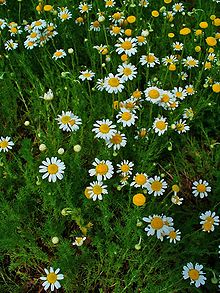- Anthemis nobilis
-
Roman Chamomile 
Scientific classification Kingdom: Plantae (unranked): Angiosperms (unranked): Eudicots (unranked): Asterids Order: Asterales Family: Asteraceae Tribe: Anthemideae Genus: Anthemis Species: A. nobilis Binomial name Anthemis nobilis
L.Synonyms Chamaemelum nobile
Anthemis nobilis [synonym: Chamaemelum nobile], commonly known as Roman Camomile, Chamomile, garden camomile, ground apple, low chamomile, English chamomile, or whig plant, is a low perennial plant found in dry fields and around gardens and cultivated grounds. It has daisy-like white flowers that are found in Europe, North America, and Argentina. The stem is procumbent, the leaves alternate, bipinnate, finely dissected, and downy to glabrous. The solitary, terminal flowerheads, rising 8 to twelve inches above the ground, consist of prominent yellow disk flowers and silver-white ray flowers. The flowering time is June and July, and its fragrance is sweet, crisp, fruity and herbaceous.[1]
The plant is used to flavor foods, in tisanes, perfumes, and cosmetics.[1] It is used to make a rinse for blonde hair, and is popular in aromatherapy, whose practitioners believe it to be a calming agent to end stress and aid in sleep.[citation needed]
The word chamomile comes from Greek χαμαίμηλον (chamaimēlon), "earth-apple"[2], from χαμαί (chamai), "on the ground" + μήλον (mēlon), "apple", so called because of the applelike scent of the plant. (Note: The "ch-" spelling is used especially in science and pharmacology.)
Contents
Culture
The Chamomile is mentioned in Shakespeare's Henry IV, part 1 'The Camomile; The more it is trodden on, the faster it grows'.
Mary Wesley's novel The Camomile Lawn was also televised in Great Britain in the 1990s.
The lawns of Buckingham Palace, London use camomile instead of grass.
Folklore
Use of Chamomile dates back as far as ancient Egypt where it was dedicated to their gods.[citation needed] Folk remedies using the plant include treatments for dropsy and jaundice. It was also believed to revive any wilting plant placed near it.[citation needed] The flowers were also used as a dye to lighten hair.
Medical properties
Chamomile is considered to be an antiseptic, antibiotic, disinfectant, bactericidal & Vermifuge.[3]
References
- ^ a b Gualtiero Simonetti (1990). Stanley Schuler. ed. Simon & Schuster's Guide to Herbs and Spices. Simon & Schuster, Inc. ISBN 0-671-73489-X.
- ^ Chamaimelon, Henry George Liddell, Robert Scott, A Greek-English Lexicon, at Perseus
- ^ Health Benefits of Camomile Essential Oil
- Howard, Michael. Traditional Folk Remedies (Century, 1987), p. 112.
 This article incorporates public domain material from the U.S. National Cancer Institute document "Dictionary of Cancer Terms".
This article incorporates public domain material from the U.S. National Cancer Institute document "Dictionary of Cancer Terms".External links
- English chamomile entry in the public domain NCI Dictionary of Cancer Terms
- Chamomile Plantlife website - species listing
Categories:- Herbs
- Anthemis
- Asteraceae genera
- Asteroideae stubs
- Alternative medicine stubs
Wikimedia Foundation. 2010.

